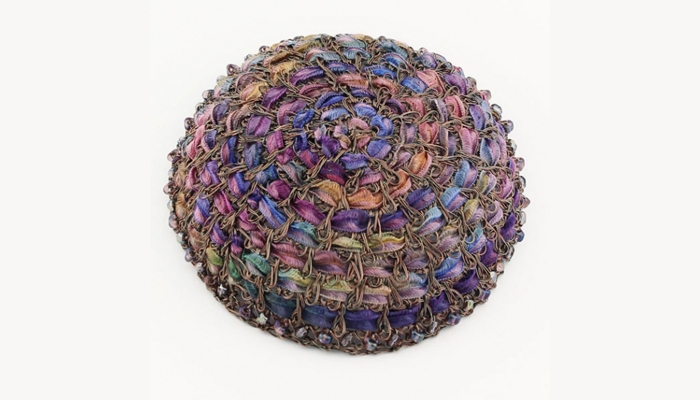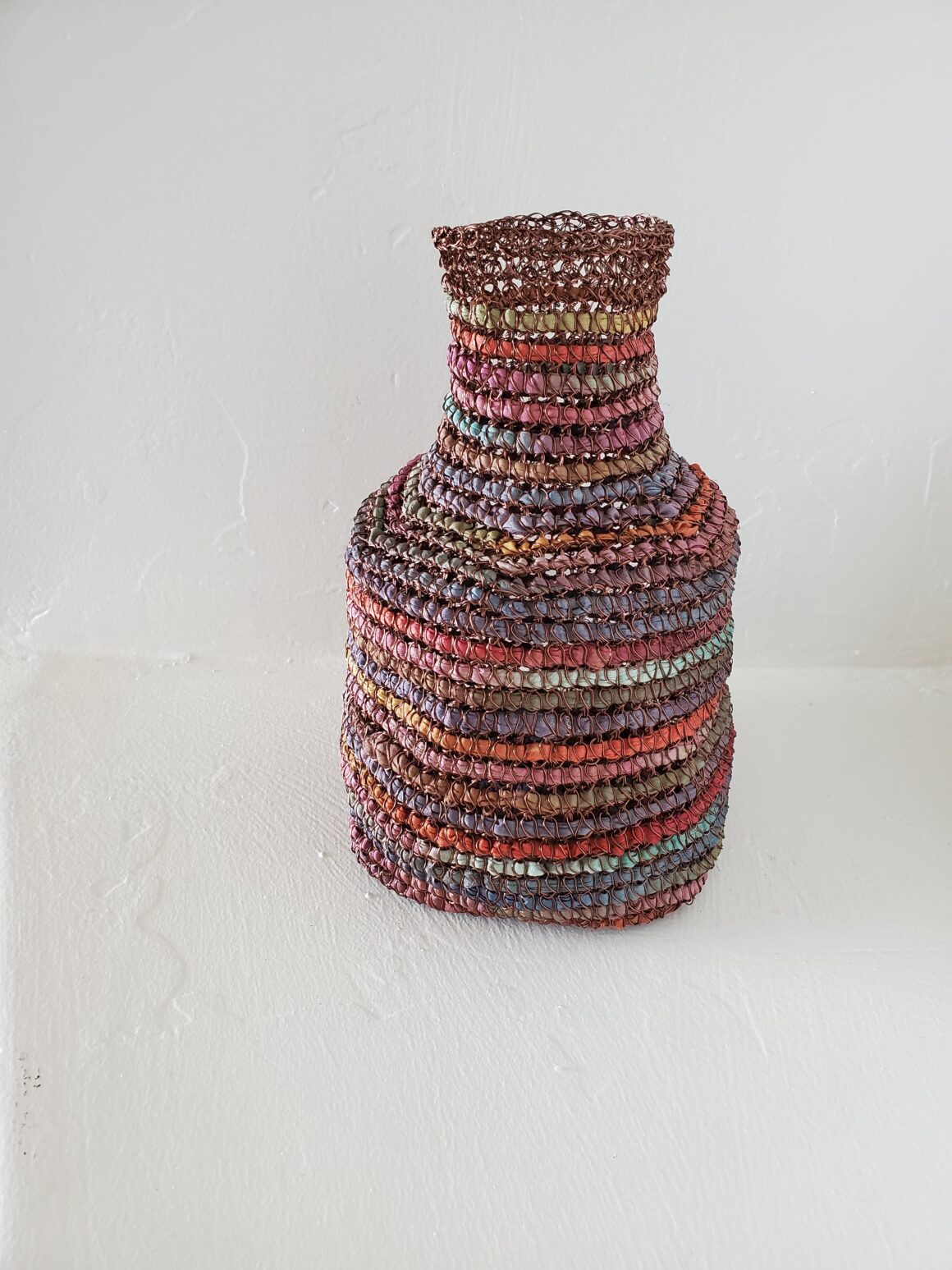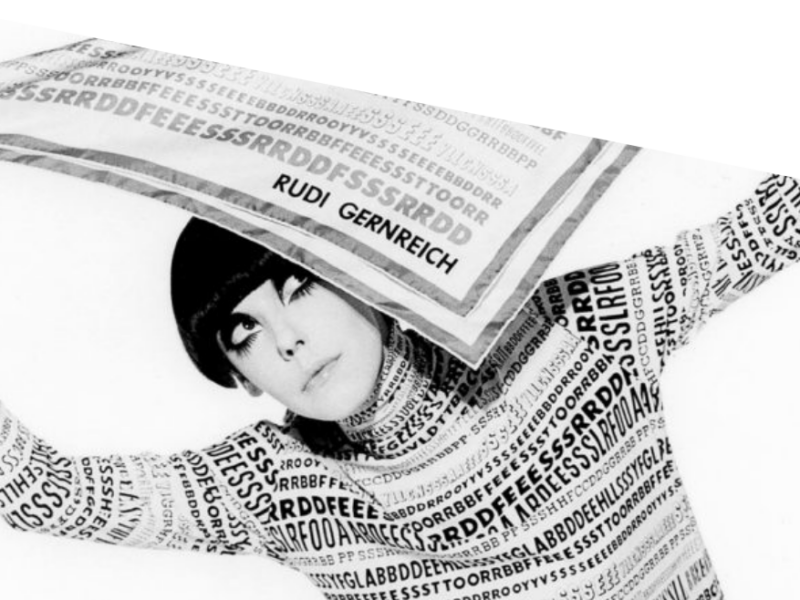Photo: Rose Garden – antique copper crocheted wire kippah with variegated rose and purple ribbon yarn and beaded edge.
Tucson artist Jere Moskovitz says that she was always a “textile kind of person.” She was taught how to knit and crochet by her mother and grandmother as a young girl. After earning a BFA in Apparel Design from the Rhode Island School of Design, Jere began a 20-year career in the apparel industry. Her work took her to yarn mills, dye factories and yarn shows throughout Europe and Asia, which further cemented her love of textiles.
In 2010, Jere was searching for a particular kippah to wear to her son’s bar mitzvah. “I ended up having one made by somebody who had a different kind of look than what the typical ones were,” says Jere. “When I got it, I said, ‘Wow, I can do this. I can do better than this.”
She started researching crocheting with wire. Jere tried knitting the wire as she would yarn, with standard knitting needles. But wire doesn’t have the same kind of give as fiber does, so she wasn’t pleased with the results.
Then Jere discovered fiber artist Adrienne Sloane from Massachusetts. She was intrigued by the look she was achieving with her wirework, so she signed up for a class with her. When the class was canceled, Jere was able to book some one-on-one time with Adrienne at her studio.
“I spent a weekend with her, which was the most incredible experience of my life,” shares Jere. “I had never taken classes. I was self-taught on a lot of things as an adult, and she taught me this method – there is really no name for it – I’ve seen it referred to as a finger loop knitting.”
Jere explains that you form stitches on a mandrel or anything round – like a pencil or knitting needle. Then as you go, you flatten out the stitches and manipulate them to connect to one another. The result is a knitted piece with an even structure.
She had been experimenting with this technique when a friend approached her and asked if she would make her a kippah for her son’s bar mitzvah. This woman was a jewelry maker, and asked Jere if she would incorporate beads into the headpiece.
“I didn’t even own a bead at that point because I’d never done any beadwork,” says Jere. The woman supplied the beads and was thrilled with the results.
“I showed it to my friends that were at my synagogue that worked in the gift shop, and they said, ‘Oh, that’s really cool. You should make some for the gift shop.’ So I made a couple of dozen, and they let me show them at their Hanukkah boutique.”
Jere was having a challenge with how to price her items, so she consulted the owner of The Aesthetic Sense in New York, who was very knowledgeable about the Judaica market. She sold everything from high-end Judaica art to women’s tallitot and kippot.
She liked Jere’s work, so she started leaving her a few dozen kippot on consignment, “We had a good relationship for several years,” says Jere. “She ultimately ended up closing her retail store, but she still sells online.”
As more and more people started seeing Jere’s art, people would tell her that they loved her work, but they don’t wear a kippah, and started asking, “Why don’t you make jewelry?”
In fact, Jere had been experimenting with making jewelry, but she hadn’t quite found the right clasps and findings in the metal she liked working with. “I had this particular look – antique copper, vintage bronze, titanium, hematite – those are my colors,” says Jere. “Sometimes I combined two colors, so I’d get an iridescent effect, but I had to find clasps that matched to the wire. So once I found those then things took off in the jewelry department.”
After making her kippot for about six months, Jere was made aware of a head covering exhibition in Canada. She knew that she had to “push the envelope” on her creations if she was to be chosen for this show, so she began weaving yarns and ribbons in a variety of textures and colors along with the wire. Both of the pieces she entered were selected for the exhibit.
Being in that exhibit gave Jere the confidence to apply to a large, high-end Judaica show held annually in White Plains, NY.
“It was a limited, juried application process. I had (artist) friends that tried and couldn’t get in,” says Jere. “My first year I got into that show and sold very well. I only had a little bit of a jewelry presentation, but I had a big kippot presentation, and that was very exciting. It just kind of helped me get into that world of Judaica shows, and it blossomed from there.”
Jere’s kippot and jewelry can be found at specialty shops and galleries; she prefers people seeing the work in person instead of selling online because of her pieces’ tactile nature. Mostly she sells her art through shows across the country, and since the pandemic, those have stopped. But her creativity hasn’t.
Her jewelry work is continually evolving, in addition to her “chunky necklaces,” she has been creating more delicate, longer necklaces and also pendants that are woven with seed beads and can be interchangeable. Shas also added a new piece to her repertoire – baskets. “I took some silk sari ribbon and captured it in a basket as I was crocheting it, and I really love that look so I made maybe half a dozen baskets at the beginning of the quarantine.”
She does admit that she has “backed off” a little in the production department. “When the pandemic first occurred, I was like, ‘I’ve got loads of materials, I can just keep creating. After filling in some inventory on jewelry, I thought, ‘I’m not going to keep doing this because I have no idea when I’m going be able to do a show again.”
Until we can see Jere’s art at a show, you can see her art at studiojere.com or by contacting [email protected].








